完整word版,新人教版五年级下册英语第一单元教案
【完整打印版】人教版小学五年级下册第一单元英语教案

【完整打印版】人教版小学五年级下册第一单元英语教案(此文档为word格式,下载后您可任意编辑修改!)五年级下册英语第一周教学设计备课学校:通远镇中心小学备课教师:王媛英课This is my day 课第一课时题时教学内容Let’s start Let’s chant A.Let’s learn Let’s play C.Let’s sing教学目标知识技能:1、能够听、说、读、写以下动词短语:eat breakfast , do morning exercises , do you do morning exercises/……并能用所学动词短语替换句型“I usually …at…”中的关键词回答问句。
过程与方法:通过练习,能够理解并说唱Let’s chant 部分的歌谣。
情感态度价值观:能够了解Good to know 部分的内容,了解中西文化差异。
教学重点掌握A部分中的五个动词短语,并能用这些回答询问作息时间的问题。
教学难点exercises , ususlly 的发音。
课程类型新授课教学准备录音机和相关的录音带学具准备五个动词短语的教学卡片教学方法引导法讲授法学习方法观察思考自主探究合作交流教学过程修改意见教师活动学生活动1.热身/复习(Warm-up/Revision)(1)Let’s do:Time for breakfast.Drink some milk.(2)Let’s start:Listen and write.(3)Free talk:T:What day is it today?S:It’s Monday.T:What do you Mondays?S:We Mondays.T:Do you like Mondays?Why?对话练习做游戏,学习新词组对话练习学生巩固所学知识S:...2.呈现/操练(Presentation/Practice)(1)游戏:Guess! What am I doing ? 引出新动词词组:do morning exercise , you do ? I can do morning exercises .What can you do ? Ican ……(3)在黑板上画一口钟,标出时间。
人教精通版英语五年级下册Unit1 Lesson1【教学设计】
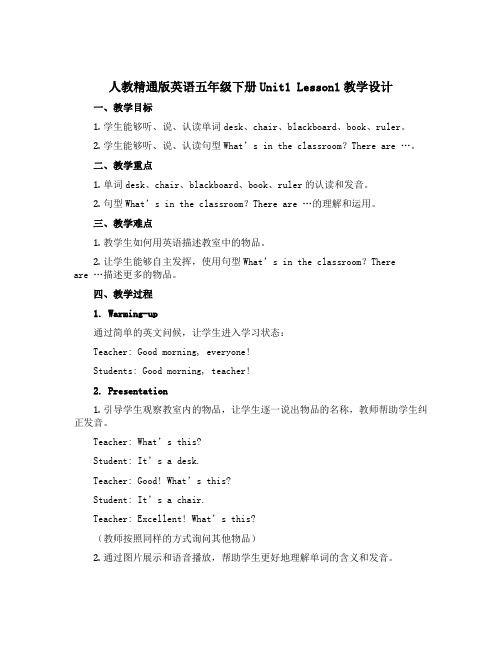
人教精通版英语五年级下册Unit1 Lesson1教学设计一、教学目标1.学生能够听、说、认读单词desk、chair、blackboard、book、ruler。
2.学生能够听、说、认读句型What’s in the classroom?There are …。
二、教学重点1.单词desk、chair、blackboard、book、ruler的认读和发音。
2.句型What’s in the classroom?There are …的理解和运用。
三、教学难点1.教学生如何用英语描述教室中的物品。
2.让学生能够自主发挥,使用句型What’s in the classroom?Thereare …描述更多的物品。
四、教学过程1. Warming-up通过简单的英文问候,让学生进入学习状态:Teacher: Good morning, everyone!Students: Good morning, teacher!2. Presentation1.引导学生观察教室内的物品,让学生逐一说出物品的名称,教师帮助学生纠正发音。
Teacher: What’s this?Student: It’s a desk.Teacher: Good! What’s this?Student: It’s a chair.Teacher: Excellent! What’s this?(教师按照同样的方式询问其他物品)2.通过图片展示和语音播放,帮助学生更好地理解单词的含义和发音。
3. Practice1.带着学生使用句型What’s in the classroom? There are …来描述教室中的物品。
Teacher: What’s in the classroom?Student: There are four desks, six chairs, a blackboard, some books and a ruler.2.让学生以小组为单位,在课堂上巡视一圈,自主发挥,使用句型What’s in the classroom?There are …来描述教室中的更多物品。
五年级下册英语教案-Unit1 Keeping Healthy Lesson1∣人教新起点
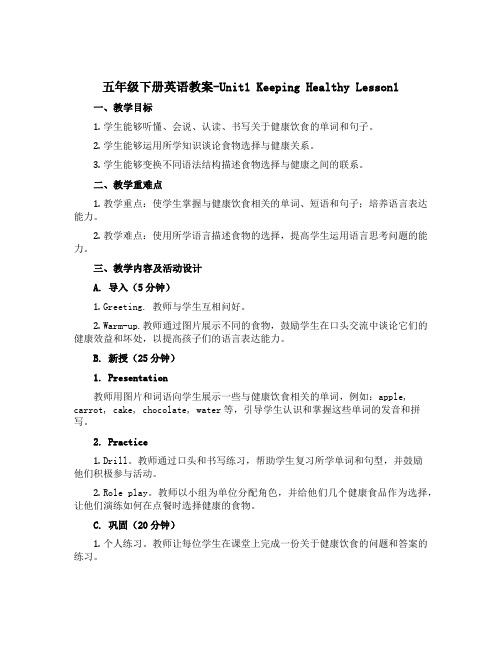
五年级下册英语教案-Unit1 Keeping Healthy Lesson1一、教学目标1.学生能够听懂、会说、认读、书写关于健康饮食的单词和句子。
2.学生能够运用所学知识谈论食物选择与健康关系。
3.学生能够变换不同语法结构描述食物选择与健康之间的联系。
二、教学重难点1.教学重点:使学生掌握与健康饮食相关的单词、短语和句子;培养语言表达能力。
2.教学难点:使用所学语言描述食物的选择,提高学生运用语言思考问题的能力。
三、教学内容及活动设计A. 导入(5分钟)1.Greeting. 教师与学生互相问好。
2.Warm-up.教师通过图片展示不同的食物,鼓励学生在口头交流中谈论它们的健康效益和坏处,以提高孩子们的语言表达能力。
B. 新授(25分钟)1. Presentation教师用图片和词语向学生展示一些与健康饮食相关的单词,例如:apple, carrot, cake, chocolate, water等,引导学生认识和掌握这些单词的发音和拼写。
2. Practice1.Drill。
教师通过口头和书写练习,帮助学生复习所学单词和句型,并鼓励他们积极参与活动。
2.Role play。
教师以小组为单位分配角色,并给他们几个健康食品作为选择,让他们演练如何在点餐时选择健康的食物。
C. 巩固(20分钟)1.个人练习。
教师让每位学生在课堂上完成一份关于健康饮食的问题和答案的练习。
2.小组活动。
教师分成小组,让他们一起讨论食物的选择与健康之间的关系。
让他们写下自己小组讨论的内容,并在班上分享。
D. 作业(5分钟)1.翻译。
让学生用所学语言翻译一段关于健康饮食的文章。
2.背诵。
要求学生背诵所学习的单词、短语和句子。
四、教学后记本课主要介绍了与健康饮食相关的词语和句子,并通过活动让学生练习如何根据自身需要选择健康的食品。
在课程实施中,教师应注意调动学生的积极性和参与度,并适当调整教学内容和形式,以满足不同学生的学习需求。
人教PEP版英语五下Unit 1《My day》word教案

人教PEP版英语五下Unit 1《My day》word教案一. 教材分析人教PEP版英语五下Unit 1《My day》主要介绍了学生们日常的作息时间和活动。
通过本单元的学习,学生们能够掌握关于日常活动的一些基本词汇,如:wake up, get up, brush my teeth, have breakfast等,并且能够运用这些词汇描述自己的一天。
本课时的教学内容紧紧围绕学生的日常生活,旨在提高学生们用英语进行交流的能力。
二. 学情分析五年级的学生已经具备了一定的英语基础,对于日常生活中的事物和活动有一定的认识。
学生们在学习过程中能够积极参与,乐于表达,但部分学生对英语学习的兴趣有待提高。
此外,学生们在语言表达方面存在一定的困难,需要教师耐心引导和鼓励。
三. 教学目标1.知识目标:–能够听懂、会说、会读本单元的生词和重点句子。
–能够运用所学词汇和句型描述自己的一天。
2.能力目标:–能够用英语进行简单的日常交流,提高学生的口语表达能力。
–培养学生的团队合作精神,提高学生的交际能力。
3.情感目标:–激发学生学习英语的兴趣,增强学生的自信心。
–培养学生热爱生活、积极向上的态度。
四. 教学重难点•掌握本单元的生词和重点句子。
•能够运用所学词汇和句型描述自己的一天。
•正确运用动词的时态描述日常活动。
•如何在实际情境中灵活运用所学知识进行交流。
五. 教学方法1.情境教学法:通过设定各种日常情境,让学生在实际语境中学习、运用英语。
2.互动教学法:引导学生积极参与课堂活动,培养学生的主体意识。
3.任务型教学法:通过完成各种任务,提高学生的实践能力。
4.激励评价法:注重鼓励学生,激发学生的学习兴趣。
六. 教学准备1.准备本单元的生词卡片和图片。
2.制作课件,包括教材中的插图和相关视频。
3.准备录音机和磁带,或者使用多媒体设备播放音频。
4.准备课堂活动的道具和材料。
七. 教学过程1.导入(5分钟)–教师与学生用英语进行简单的交流,询问学生们的日常活动。
人教版五年级英语下册Unit 1教案
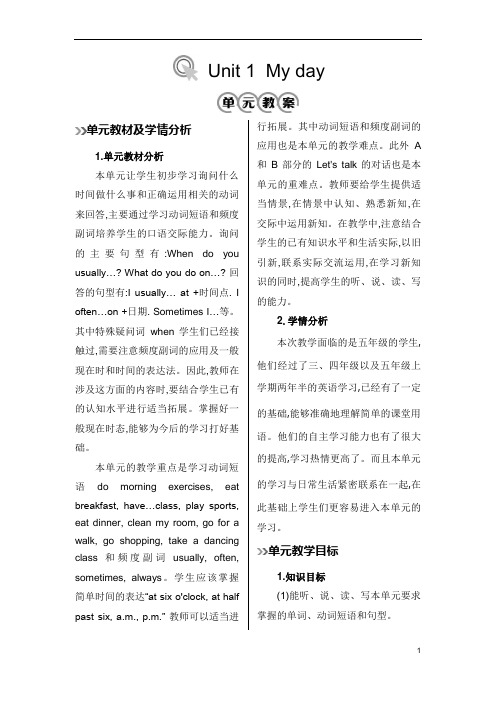
Unit 1 My day单元教材及学情分析1.单元教材分析本单元让学生初步学习询问什么时间做什么事和正确运用相关的动词来回答,主要通过学习动词短语和频度副词培养学生的口语交际能力。
询问的主要句型有:When do you usually…? What do you do on…? 回答的句型有:I usually… at +时间点. I often…on +日期. Sometimes I…等。
其中特殊疑问词when学生们已经接触过,需要注意频度副词的应用及一般现在时和时间的表达法。
因此,教师在涉及这方面的内容时,要结合学生已有的认知水平进行适当拓展。
掌握好一般现在时态,能够为今后的学习打好基础。
本单元的教学重点是学习动词短语do morning exercises, eat breakfast, have…class, play sports, eat dinner, clean my room, go for a walk, go shopping, take a dancing class和频度副词usually, often, sometimes, always。
学生应该掌握简单时间的表达“at six o'clock, at half past six, a.m., p.m.”教师可以适当进行拓展。
其中动词短语和频度副词的应用也是本单元的教学难点。
此外A 和B部分的Let's talk的对话也是本单元的重难点。
教师要给学生提供适当情景,在情景中认知、熟悉新知,在交际中运用新知。
在教学中,注意结合学生的已有知识水平和生活实际,以旧引新,联系实际交流运用,在学习新知识的同时,提高学生的听、说、读、写的能力。
2.学情分析本次教学面临的是五年级的学生,他们经过了三、四年级以及五年级上学期两年半的英语学习,已经有了一定的基础,能够准确地理解简单的课堂用语。
他们的自主学习能力也有了很大的提高,学习热情更高了。
人教版小学五年级下册英语unit1教案

人教版小学五年级下册英语unit1教案教案标题:人教版小学五年级下册英语 Unit 1 教案教案目标:1. 学习并复习有关自我介绍的基本句型和表达方式。
2. 掌握使用第一人称单数和第三人称单数进行自我介绍的能力。
3. 提高学生的听说读写能力,培养学生的英语交流能力。
教学重点:1. 学习并掌握自我介绍的基本句型和表达方式。
2. 进行口语训练,提高学生的口语表达能力。
教学难点:1. 学生能够运用所学的句型和表达方式进行自我介绍。
2. 学生能够流利地进行口语交流。
教学准备:1. 课本《人教版小学英语五年级下册》Unit 1 的教材和课件。
2. 包含自我介绍的图片、卡片或者实物。
教学过程:Step 1:导入新课 (5分钟)1. 与学生打招呼,引起学生兴趣。
2. 准备一些图片、卡片或实物,用英语进行自我介绍,鼓励学生回答问题或进行简单交流。
Step 2:学习新知 (20分钟)1. 向学生展示课本 Unit 1 的相关内容,引导学生预测新课内容。
2. 播放课件或展示图片,教授有关自我介绍的基本句型和表达方式。
3. 通过示范和练习,让学生掌握并熟练运用这些句型和表达方式。
Step 3:巩固练习 (15分钟)1. 分组活动:将学生分成小组,让他们在小组内互相进行自我介绍。
2. 教师巡视各小组,给予学生指导和帮助,同时记录学生的表现和进步。
3. 鼓励学生积极参与,提高他们的口语表达能力。
Step 4:拓展延伸 (10分钟)1. 给学生一些拓展练习,如编写自己的自我介绍短文或制作自我介绍的海报。
2. 鼓励学生使用所学的句型和表达方式,进行口头或书面的自我介绍。
Step 5:课堂总结 (5分钟)1. 回顾本节课所学的内容,强调自我介绍的重要性和运用方法。
2. 鼓励学生积极参与英语学习,提高英语交流能力。
Step 6:课后作业1. 布置适当的课后作业,如写一篇关于自己的自我介绍短文或制作一份自我介绍的海报。
2. 鼓励学生在家继续练习口语表达和写作能力。
五年级下册英语人教版第一单元教案

能听懂、会说:My schoolbag is heavy. Whats in it? Thank you so much! How many....do you have?并能在实际情景中运用。
一起看看五年级下册英语人教版第一单元教案!欢迎查阅!五年级下册英语人教版第一单元教案1教学目标:1、能听懂、会说:My schoolbag is heavy. Whats in it? Thank you so much! How many....do you have? 并能在实际情景中运用。
2、进行小组合作,完成 Group work 中简要调查,完成Lets check中简要评价。
3、培养学生的同情心、爱心和合作精神。
教学重难点:重点:听、说、认读句型My schoolbag is heavy. Whats in it? Look! 10 sharpeners......难点:运用所学新句型和“小组合作”学习。
课前准备:1、教师准备本课相关的课件,主要人物头饰及文具用品,一块标有“希望小学”字样的标牌。
2、教师准备录音机及相关录音带。
3、学生准备一些文具:蜡笔,铅笔以及各类书。
教学过程:一、热身、复习1、唱歌:“Books and pencils”2、教师播放Lets chant 部分录音,师生边做边吟唱该部分内容:(How many English books do you have? Thirty! Thirty! Thirty!)3、复习单词:①、用课件出示一个房间,里面有各类书放在不同的地方,老师问:“How many English/Chinese... books can you see?”请学生把它们找出来,用I can see...句型回答。
②、课件出示三种小动物,它们背着一个书包,请学生猜一猜书包里有些什么文具?二、新课呈现1、教学 “My schoolbag is heavy.”教师展示自己的新书包,拿给全班学生看:I have a new schoolbag. My schoolbag is heavy. 引导学生朗读“My schoolbag isheavy.”注意heavy的发音。
五年级下册英语人教版第一单元教案

五年级下册英语人教版第一单元教案五年级英语下册第一单元的教案篇一本节课是本学期开学的第一课,教师可以充分利用生活情景介绍新来的学生。
本节课是本单元的。
基础,重点是让学生听懂会说一些简单的问候语,并能介绍自己。
这也是本节课的难点。
主要采取师生、生生互相合作,学生在愉快的学习氛围中习得和学得。
【学生分析】学生刚开学,学习热情比较高,情绪比较高昂。
尤其是来了新学生后,学生们都会有好奇心,喜欢结交新朋友。
可通过学生的兴趣与积极性,营造学习氛围。
【教学准备】教师:录音机、磁带。
学生:课本、活动手册。
【板书设计】unit 1 aboys and girls.we have a new friend today.i#39;m from america.welcome!【教学过程】一、warm-up与学生对话:good morning , boys and girls.nice to see you again.how are you?ss: i#39;m fine, thank you.how are you?t: fine, thanks.do you had a happy new year?你们新年快乐吗?ss: yes .【设计意图】:与学生进行日常会话,进行热身。
并引入情景。
二、presenation1. t: we have a new friend today.guess! who is it? a boy or a girl?生猜。
师说出答案:she is a girl.教师请进新生或假设的新生,向学生介绍。
look, she is lili. she is from qingdao.然后新生自己介绍一下自己。
(课前教师可以提前教给学生)s: hi! i#39;mlili, i#39;m from qingdao .t:welcome, lili.【设计意图】:达到师生互动教学。
2.播放let#39;s talk录音3. 教师扮演amy, 与学生打招呼。
五年级英语下册第一模块教案
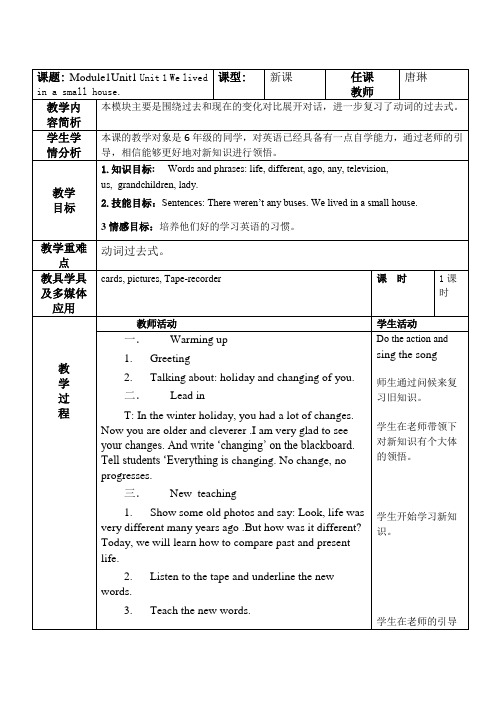
五年级英语下册第一单元教学反思学生分析:五年级学生具有贪玩、好动、好奇心强,爱表现自己的特点。
他们已经学过了四年的英语,已经具备了一定的基本知识和技能,对基本的课堂用语,教师的指令已经基本掌握,在图片的帮助下能听懂、读准英语单词和句子。
在教师的指导下能做一系列任务活动。
内容分析:本单元是要求学生学习掌握Let’s learn中的四会动词短语。
能够听懂问句When do you do morning exercises\....?并能用所学动词短语替换句型I usually...at ...中的关键词回答问并能在实际情境中运用.教学重难点 :四会单词的正确发音与书写。
熟练使用句型:“When do you get up \eat dinner ?I usually ...at...”回答作息时间本教材注重激发和培养学生学习英语的兴趣,养成良好的学习习惯和形成有效的学习策略,发展自主学习的能力和合作精神,使学生掌握听、说、读、写技能,形成一定的综合语言运用能力。
本单元的内容是同学们询问日常生活的对话展示,通过同学们之间表演的比较,让学生自己找不足,积极主动地学习,营造宽松、民主的教学气氛。
随后,通过师生对话的形式,建立融洽和谐的师生交流渠道,鼓励他们在学习中的尝试,吸引和组织他们积极参与,从而培养学生的合作精神,提高他们的口语能力。
之后又根据学生的年龄特点和认知能力,从学生的学习兴趣、生活经验和认知水平出发,充分利用图片,发挥其直观、形象的特点,在图片的帮助和提示下,使学生乐于模仿,敢于开口,在课堂上做到人人都发言,让孩子们更有兴趣,更能有一种成功的心理体验,印象也就更为深刻。
五年级英语下册第二单元教学反思五年级英语下册第二单元要求学生的能力目标是能够就所喜欢的季节及原因进行问答。
如:What’s your favouri te season?Which season do you like best?Why do you like…?Because I can …难点是要求掌握的四会词和动词。
五年级下册英语第一单元教案(通用5篇)

五年级下册英语第一单元教案五年级下册英语第一单元教案(通用5篇)作为一名教职工,有必要进行细致的教案准备工作,借助教案可以提高教学质量,收到预期的教学效果。
那么问题来了,教案应该怎么写?下面是小编整理的五年级下册英语第一单元教案,仅供参考,希望能够帮助到大家。
五年级下册英语第一单元教案篇1教学目标:1.知识与能力技能目标(1)掌握生词: lay , caterpillar , become .(2)读懂语篇,学习蝴蝶的有关知识。
2. 过程与方法目标在自主与合作交流的学习过程中,感受蝴蝶蜕变的美,学习有关蝴蝶的知识3.情感态度价值观目标培养学生热爱自然的美好情感;激发学生的探知热情,让学生体验合作的愉快,培养学生的创造力与想象力以及跨学科学习的能力。
教学重点:帮助学生读懂语篇。
教学难点:使学生能用英语讲述蝴蝶的生长过程以及介绍蝴蝶的有关知识。
教具准备:课件、录音带、蝴蝶蜕变过程视频教学过程:一、自主式导读Warming up:T: Nice to meet you ! Do you like insects ? Whichinsect do you know?Ss: ants, ladybirds, flies, butterflies…T: Among all the insects, which one is the most beautiful?S1: Butterflies.T: Yes , butterflies are one of the most beautiful insect in the world. Ihave some pictures about butterflies . Do you want to have a look ?In this lesson we are going to talk about butterflies.板书课题Module4Unit2 Butterflies(学生齐读课题)出示学习目标:(齐读学习目标,明确本节课的学习目的)1、我能听所读写单词: lay , caterpillar ,become .2、我能读懂语篇,学习蝴蝶的有关知识。
【2020新】人教版PEP五年级英语下册《Unit 1 第六课时》教案

2020人教版PEP五年级英语下册精编教案第六课时一、课时内容教科书第6页的A.Let’s spell,第10页的B.Let’s wrap it up和第11页的Story time。
二、课时分析本课时是义务教育灵通版(pep)小学英语教科书五年级下册的第一单元第六课时,依然围绕“My day”这个话题展开内容。
包括A.Let’s spell,B.Let’s wrap it up和C.Story time三个板块。
A部分的Let’s spell呈现了八幅图和对应八个单词,其中有四个单词是以cl开头的,里外四个单词含有pl字母组合,如此呈现,容易让学生们很快掌握字母组合cl和pl的读音规律。
然后通过小组内做Bingo游戏,加强学生们对含有字母组合cl或pl的反应能力,最后还设置了选择适当的单词填空完成句子的环节,这就要求学生们对这些单词不仅仅局限于会读、会认,还要会用、会说。
提高了学生们的全方位掌握新知的灵活运用能力。
B部分中的Le’s wrap it up 给出了十三个名词或名词短语,和一个含有四个动词的表格,这四个动词分别是go,play,have,do等。
是让学生们根据平时积累的动词短语情况,给这些名词或名词短语归类,可以分别与那个动词搭配构成适当的动词短语,这个活动板块可以帮助学生们把学过的知识重新归类,让日常积累的词汇在大脑中分类更清晰,思路更敏捷,学习方法更简洁方便。
C部分中的Story time中的主人公是Zip和Zoom。
是谈论有关Zip一周忙碌的活动情况。
该故事还是围绕“My day”这个话题设计的,故事中描述了Zip从星期一到星期三每天下午都忙着收集坚果,星期四又忙着把坚果晒干,星期五Zip与朋友们一起吃坚果分享快乐。
星期六Zip又忙于参加演出弹琵琶。
看得出Zip是一个勤快、善良、热情、好客、积极向上的好表率,值得学会生门学习与效仿。
本课时是整个单元的第六课时,也是最后一课时。
(完整word版)新人教版小学五年级英语下学期Unit1MyDay教案

(1)从文本走向生活,介绍新朋友Jack, Kevin, John和Steven,利用他们职业的不同,进行语言运用训练。
(2)观看Role-play视频,巩固所学句型,进行Pair work操练。
(3)小组活动:利用不同职业头饰,启发学生结合生活实际,运用句型When do you ...?和频率副词Usually, I … /At …进行问答采访。
三、目标预设
1.能够听、说、读、写5个活动词组do morning exercises, eat breakfast, have … class, play sports, eat dinner;
2.能运用所学句型“When do you …?”“At …”进行合作问答表演;
3.能根据例句仿写句子“When do you …?”“At …”。
(3)观看视频,整体感知对话的情境。
(4)完成思维导图,发现不同国家生活的差异。
(5) Let’s read
听录音,逐句跟读,教师指导学生的语音语调,并完成以下练习:
全班齐读;
以小组为单位进行角色朗读;
结合视频动画,进行男女生角色配音。
趣味操练
(Practice)
1. Let’s talk课文角色扮演
呈现新课
(Presentation)
1. Let’s try
由热身环节的问题,I go to school at 7:30.引出Zhang Peng has a new friend, Pedro. He is from Spain. When does he go to school?
教师介绍新同学Pedro。
1. Let’s chant
Get up, get up, when do you get up?
人教版英语五年级下册第一单元教学设计
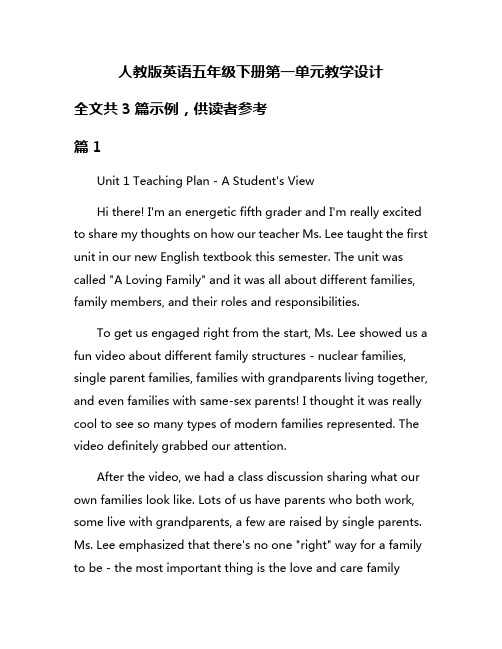
人教版英语五年级下册第一单元教学设计全文共3篇示例,供读者参考篇1Unit 1 Teaching Plan - A Student's ViewHi there! I'm an energetic fifth grader and I'm really excited to share my thoughts on how our teacher Ms. Lee taught the first unit in our new English textbook this semester. The unit was called "A Loving Family" and it was all about different families, family members, and their roles and responsibilities.To get us engaged right from the start, Ms. Lee showed us a fun video about different family structures - nuclear families, single parent families, families with grandparents living together, and even families with same-sex parents! I thought it was really cool to see so many types of modern families represented. The video definitely grabbed our attention.After the video, we had a class discussion sharing what our own families look like. Lots of us have parents who both work, some live with grandparents, a few are raised by single parents. Ms. Lee emphasized that there's no one "right" way for a family to be - the most important thing is the love and care familymembers have for each other. I really liked her open, inclusive perspective.Next up was the vocabulary preview for the unit. Ms. Lee put us into small groups and had us match vocabulary words to pictures and definitions. Words like "nephew," "aunt," "household chores," and "babysit" were really useful ones to learn for this family theme. We also played a fun guessing game called "What's My Role?" where we had to describe different family roles and responsibilities without using the actual word.For the reading texts, we first read a comic strip introducing the Jackson Family - Mom, Dad, big sister Amy, little brother Michael, and Grandma who lives with them. The comic was pretty funny, showing the typical morning chaos of getting everyone up, dressed, fed, and out the door for work and school. We analyzed the characters and talked about which family members had which responsibilities.The second reading text was a first-person narrative by a Chinese-American girl describing her extended family's big reunion dinners. I loved all the rich descriptions of different cultural foods and traditions they celebrate together as one big family. Ms. Lee had us write our own paragraphs describing a special family event or tradition from our own cultures.For listening practice, we did a fill-in-the-blanks exercise where we had to listen carefully to identify different family relationships being described. There were some tricky ones like "second cousin" that I didn't know before! We also watched a video interview with kids from around the world introducing their families. It was fascinating to me how family structures can look pretty different across cultures.The unit had quite a few fun language practice activities mixed in too. We did matching exercises identifying possessive pronouns like "her bicycle" and "their pet dog." We practiced using "have to" and "don't have to" in sentences about family obligations and rules ("I have to clean my room" or "I don't have to do yard work.") My personal favorite was when Ms. Lee had us create comic strips with speech bubbles showing a family conversation. My group's comic about a dad asking his kids to help with chores was hilarious!Towards the end of the unit, we did a fun board game-style review that helped reinforce all the family vocabulary and grammar concepts we'd learned. We had to move our game pieces around the board by answering different questions correctly. It was a nice interactive way to solidify everything before the unit test.For the final unit project, we worked in small groups to create family tree posters introducing our real families. We had to include each person's name, relationship to us, age, personality traits, and any other interesting facts like jobs, hobbies, or cultural traditions. Presenting our posters in front of the class was a little nerve-wracking at first, but it was really cool learning about my classmates' diverse families.Overall, I felt like I learned a ton about different kinds of families during this unit. Even though my own family is more traditional, it opened my eyes to see how families can look in many different ways across cultures and situations. The activities Ms. Lee planned were super engaging - not too much repetitive drills or boring stuff. I especially loved all the authentic materials she used like comics, interviews, and videos to make the lessons come alive.Most importantly, Ms. Lee created a safe, respectful environment for all of us to share our own unique family stories and perspectives. She made it clear that every family is special and valid in its own way. I left this unit feeling a deeper appreciation for the rich diversity of families in our world. Can't wait to see what thought-provoking themes we explore next!篇2Unit 1: My HobbiesTeaching PlanHello everyone! I'm really excited to share my thoughts on the new unit we're starting in our English class - Unit 1: My Hobbies. This unit looks super fun and interesting. Let me walk you through what I think we'll be learning and how our teacher might structure the lessons.Lesson 1: What do you like doing?In this first lesson, I think our teacher will introduce the topic of hobbies. We'll probably start by learning some key vocabulary words related to hobbies like "reading", "singing", "playing games", "collecting" etc. I'm sure the teacher will have some fun activities planned to help us practice using these words.One activity could be playing a game of Charades or Pictionary, where we have to act out or draw different hobbies for our teammates to guess. Or maybe we'll do a vocabulary matching exercise with pictures and words. Getting up and moving around always makes vocabulary practice more engaging.After we've learned the vocab, I imagine the teacher will model a simple conversation using the sentence pattern "I like..."to talk about hobbies we enjoy. We'll likely then pair up to practice similar conversations, asking each other "What do you like doing?" and responding with our own hobbies.Lesson 2: Talking about abilitiesThe second lesson will probably focus on using "can" to talk about abilities related to our hobbies. For example, "I can play the piano" or "I can draw pictures". The teacher will guide us through example sentences and have us identify the patterns.For practice, we could play a fun game like "Ability Charades" where one person acts out an ability and we have to guess and say the full sentence, like "You can swim!" Or we might do a running dictation activity where sentences are posted around the room and we have to remember and write them down.Lesson 3: Introducing hobbiesIn this lesson, I think we'll learn how to introduce our hobbies to others in more detail. We'll practice using sentences like "My hobby is..." and "I'm interested in...". The teacher may model an example paragraph introducing a hobby.For practice, we could get into small groups and introduce our own hobbies to each other. The teacher might give us agraphic organizer to plan out what we want to say. Or we could do a fun "Hobby Fair" activity where we move around the room sharing our paragraphs like we're at a real exhibition.Lesson 4: Describing favoritesThis lesson will probably focus on using the phrase "My favorite..." to describe our most beloved hobbies, games, books, movies, etc. We'll learn how to extend our sentences to give more details too.The teacher could have us study some model sentences or paragraphs first. Then we might get into pairs and interview each other about our favorites, taking notes to report back to the class. Or we could create fun posters or videos introducing our favorite things.Lesson 5: Reading & WritingFor the last lesson of the unit, we'll likely read a short text or watch a video about someone's hobbies. We'll learn strategies for understanding the main ideas and details. The teacher may have us answer comprehension questions or fill out a graphic organizer.Then for writing practice, I imagine we'll have to produce a short paragraph or essay introducing ourselves and our hobbies,using all the language from the unit. The teacher will probably model the writing process from planning to drafting to revising. We may even get to creatively illustrate our writing pieces.Review & AssessmentOf course, we'll regularly review the language from previous lessons through fun games and activities. And at the end of the unit, I'm sure there will be some kind of unit test or performance assessment where we get to show off everything we've learned!Overall, I'm really looking forward to this engaging unit on hobbies. It'll be cool to learn about my classmates' interests while practicing useful expressions in English. I hope my guesses about the activities and lesson focuses are accurate! Our teacher always has such an engaging and practical approach. I can't wait to get started exploring this new unit.篇3Unit 1: A DreamerHi there! I'm so excited to share with you my thoughts on the first unit we'll be covering in our new English textbook. This unit is called "A Dreamer" and it's all about learning to express our hopes and dreams for the future. As a fifth-grader, I have lotsof big dreams that I can't wait to explore through the texts and activities in this unit!The unit starts off with a really cool text called "My Dream of Dreams." It's a first-person narrative by a young person describing their ultimate dream. I loved reading about their vision for the future and all the ambitious goals they want to achieve. It really got me thinking about my own dreams and aspirations. Maybe I'll dream of becoming a famous scientist who discovers a cure for cancer? Or an explorer who travels to distant planets? The possibilities seem endless at this age!After reading the text, we'll practice summarizing the main idea and key details. Our teacher will guide us through identifying the different tenses the narrator uses to describe their dreams, like the simple future ("I will revolutionize science") and be going to future ("I'm going to explore uncharted territories"). Learning about tense usage will help me express my own dreams more clearly.Then we'll move on to a funny comic strip called "Dream Jobs." The characters are debating what kinds of dream jobs they'd like to have when they grow up. Seeing their different perspectives was really thought-provoking. While one character wants to be a video game designer, another aspires to be adolphin trainer! Analyzing the dialogue will strengthen our reading comprehension abilities.My favorite part of the unit is bound to be the project we get to do on "Living Your Dream." We'll research careers that align with our biggest dreams and create presentations to share with the class. I can't wait to learn more about the education and skills required for my dream job. Doing this project will be amazing practice for developing research, writing, and public speaking skills that are so important.Of course, no unit would be complete without engaging speaking activities! We'll spend time discussing our dreams with partners and trying to offer encouragement and feedback. For example, if my partner says their dream is to become a famous singer, I might say "That's a wonderful dream! Have you considered taking voice lessons?" These conversations will help me use language to express hopes, offer suggestions, and give compliments.Towards the end of the unit, we'll read a poem called "The Land of Dreams" that uses vivid imagery to depict an imaginary dreamscape. Figurative language is one of my favorite things about poetry, so I'm really looking forward to analyzing themetaphors and sensory details in this text. Our teacher might even have us try creating our own dream poetry!Overall, I have a feeling this is going to be one of my favorite units we've done so far. The theme of dreams resonates so much with me at this age when I'm starting to really consider my future goals and aspirations. Plus, the reading passages seem super engaging and the activities look like a lot of fun. Expressing hopes and dreams is a crucial communication skill, so I'm grateful we get to practice it in-depth.I can't wait to jump in and get started exploring Unit 1: A Dreamer! This unit will be a great opportunity to expand my English abilities while also discovering more about myself and the amazing dreams that may await me. Let the learning and dreaming begin!。
小学英语五年级下册《Unit 1 My day》教学设计(人教PEP版)
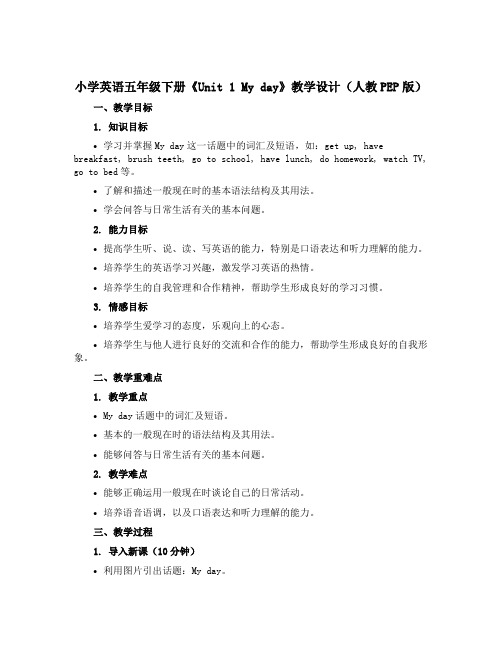
小学英语五年级下册《Unit 1 My day》教学设计(人教PEP版)一、教学目标1. 知识目标•学习并掌握My day这一话题中的词汇及短语,如:get up, have breakfast, brush teeth, go to school, have lunch, do homework, watch TV, go to bed等。
•了解和描述一般现在时的基本语法结构及其用法。
•学会问答与日常生活有关的基本问题。
2. 能力目标•提高学生听、说、读、写英语的能力,特别是口语表达和听力理解的能力。
•培养学生的英语学习兴趣,激发学习英语的热情。
•培养学生的自我管理和合作精神,帮助学生形成良好的学习习惯。
3. 情感目标•培养学生爱学习的态度,乐观向上的心态。
•培养学生与他人进行良好的交流和合作的能力,帮助学生形成良好的自我形象。
二、教学重难点1. 教学重点•My day话题中的词汇及短语。
•基本的一般现在时的语法结构及其用法。
•能够问答与日常生活有关的基本问题。
2. 教学难点•能够正确运用一般现在时谈论自己的日常活动。
•培养语音语调,以及口语表达和听力理解的能力。
三、教学过程1. 导入新课(10分钟)•利用图片引出话题:My day。
•让学生通过图片描述“洗脸”、“刷牙”等日常活动,引导学生进入Myday这一话题。
•引导学生回答问题:“What do you usually do in the morning?”2. 新课讲解(30分钟)•通过图片和语音练习帮助学生学习词汇及短语,如:get up, have breakfast, brush teeth, go to school, have lunch, do homework, watch TV, go to bed等。
•通过示范和训练,教授一般现在时的语法结构及其用法,包括:主语+动词原形+其他,例如:I get up at six o’clock. He goes to school by bus. They have lunch at noon.等。
五年级下册英语人教版第一单元教案(精选8篇)

五年级下册英语人教版第一单元教案(精选8篇)五年级英语下册第一单元的教案篇一一、教法建议本单元主要内容是让学生能听、说、读、写四会,掌握从A到N14个英语字母,并能正确辨认其中的三个元音字母,即Aa,Ee,Ii。
能认读其印刷体和手写体字母的大小写形式,注意书写格式、笔划、笔顺合乎标准,培养学生良好的书写习惯。
【抛砖引玉】1.英语字母教学是入门阶段的一项主要的教学内容,为了使字母教学任务顺利完成,应通过看、听、说、练四个方面解决。
(1)看是指看老师口型,善于模仿教师发音。
(2)听是指听录音学字母,对初学者来说Cc,Gg和Jj是比较难读准的,因此应仔细去听。
(3)说是指实践,即通过听、看过程使学生达到独立地、正确地读出字母。
(4)练是指通过看、听、说的反复训练,善于发现错误并及时纠正。
2.积极创设语境,培养学生交际能力。
(1)本单元的口语训练主要围绕Greeting展开教学,教师应引导学生运用Hello! What‘s your name? My name is...进行会话。
(2)教师以身示范,亲切地向学生打招呼,尽量给学生创造英语情景,如:Hello!或Good morning, My mane is Lin Lina. What’s your name? How are you?等,通过语言交流方式,培养学生的语言表达能力。
(3)运用TPR(Total Physical Response)培养学生反应能力和语言感知能力。
如:Stand up! sit down, please. Listen to me. Open your books. Close your books 等课堂用语,教师可用手势表明其含义。
学生听懂后,会迅速做出正确反应。
(4)使用pair work培养学生自我展示能力。
【指点迷津】本单元难点知识1.字母的书写格式。
对初学者来讲,小学的汉语拼音对学习英语字母有一定的干扰。
应引导学生仔细观察14个字母的大小写格式,避免书写错误,做到书写正确、美观。
Unit1MydayPartALet'slearn(教案)-人教PEP版英语五年级下册

7.Game time:打地鼠,巩固所学词汇。
8.Let’s learn:播放learn部分动画,学生跟读,并模仿语音语调,讲解句型
人教PEP英语五年级下册Unit 1 My day PA Let's learn课时教案
课题
PA Let'slearn
单元
Unit1
学科
英语
年级
五下
核心素养教学目标
(一)语言知识目标:
1.能在图片和文本语境的帮助下,熟练运用本单元的核心单词和句型,
2.能正确运用所学词汇和句型日常活动的时间等相关问答, 大胆说英语。
2.Lead in!呈现图片What do you often do on school days?提出疑问并根据Mike的表进行回答!
3.Lead in!呈现图片Who is he?Pedro,A newstudent here.提出问题,What does Pedro do on school days?引出新知
的学习兴趣。
4.突心语用功能,通过创设合理的情景,帮助学生在情景中真实自然地使用所学语言。
4.展示图片,Look. This is Pedro’s timetable.Let’s go and see.
5.Presentation:展示图片,呈现单词exercise和短语do morning exercises,讲解单词发音,书写,通过图片,音频,巧记等巩固单词。exercise意思为做早操,作为可数名词要加s
人教版五年级英语下册第一单元教案

人教版五年级英语下册第一单元教案Part 1: Teaching goals1. To learn and practice vocabulary related to school subjects, such as math, Chinese, music, art, P.E., and English.2. To learn and practice the phrases "What's yourfavorite subject?" and "My favorite subject is…".3. To practice using the present simple tense to talk about likes and dislikes.Part 2: Key points and difficulties1. Vocabulary related to school subjects.2. The phrases "What's your favorite subject?" and "My favorite subject is…".3. Using the present simple tense to talk about likes and dislikes.Part 3: Teaching aids1. Pictures or flashcards of school subjects.2. A video or audio recording of a conversation about favorite subjects.Part 4: Teaching proceduresStep 1: Warm-up (10 minutes)- Greet the students and welcome them to class.- Review the vocabulary for school subjects usingpictures or flashcards.- Ask the students questions about their favorite subjects, such as "What's your favorite subject?" and "Do you like English?"Step 2: Presentation (15 minutes)- Show a video or play an audio recording of a conversation between two students talking about their favorite subjects.- Introduce the phrases "What's your favorite subject?" and "My favorite subject is…".- Use the pictures or flashcards to elicit the names of different school subjects from the students.- Drill the pronunciation of the vocabulary and phrases with the students.Step 3: Practice (20 minutes)- Divide the class into pairs or small groups.- Have the students take turns asking and answering questions about their favorite subjects.- Monitor the students' conversations and provide feedback on their pronunciation and use of the target language.Step 4: Production (20 minutes)- Ask the students to work in pairs to create a dialogue using the target language.- Have the pairs perform their dialogues for the class.- Provide feedback and encouragement to the students as they perform their dialogues.Step 5: Homework (5 minutes)- Assign homework that reinforces the use of the target language, such as writing a paragraph about their favorite subject or having a conversation with a family member about school subjects.Part 5: SummaryIn this lesson, students learned and practiced vocabulary related to school subjects, the phrases "What's your favorite subject?" and "My favorite subject is…", and using the present simple tense to talk about likes and dislikes. Thestudents had the opportunity to practice speaking and listening skills through conversations about their favorite subjects. The lesson also provided opportunities for pair and group work, allowing the students to practice using thetarget language in context.。
人教PEP 五年级下册Unit 1 Read and write 电子版教案

2022-2023 学年五年级英语下册教案教学内容Unit 1 Read and write 课型新授课课时 2 备课教师学习目标1. Can you read the letter correctly and fluently by listening?2. Can you act out this story by cooperation in groups?3. Can you finish the exercises in our book?核心问题教学建议会使用本单元重点句型和识记本课生词(如:play,Robinson)主干问题及问题化系统主干问题:学生如何学会运用重点句型去写作问题系统化:1.学生自学本篇课文2.小组合作讨论书信书写格式3.小组展示和开始写作4.学生展示,老师点评教学环节个人批注课前准备英语课本、两个练习本、黑笔、红笔一、Let’s read(1)Read the letter twice by yourself.(2)Listen to the tape and pay attention to the pronunciation.(3) Listen to the tape again and follow it .(4) Read the passage together loudly.Let’s check1.Answer the questions2.Tick or cross二、Let’s studyDiscuss the question you can't understand during the reading.三、Let’s talkMake some new sentences using the key sentences.四、Let’s practice一、英译汉 二、单项选择教学反思1. a letter _______2. an island ______3. live on ______4. wash my face ______5.clean my cave ____6. play the pipa____ ( ) 1. Here is a letter________ your mum. A. at B. in C. from ( ) 2. Robinson lives on________ island. A. a B. an C. some ( ) 3. I________ go for a walk. A.sometimes B.some times C.sometime。
- 1、下载文档前请自行甄别文档内容的完整性,平台不提供额外的编辑、内容补充、找答案等附加服务。
- 2、"仅部分预览"的文档,不可在线预览部分如存在完整性等问题,可反馈申请退款(可完整预览的文档不适用该条件!)。
- 3、如文档侵犯您的权益,请联系客服反馈,我们会尽快为您处理(人工客服工作时间:9:00-18:30)。
()月()日总第()课时
Ss: At… o’clock.(跟学生强调整点前要用介词at) 反复操练。
4. 学生听录音,分角色读Let’s learn 。
Step 3. 合作交流,师生共建(用时8分钟)新课标第一网
Role- play:
1) Answers the questions.
T: What time is it? Ss: It’s six/nine o’clock.
T: I get up at six o’clock. When do you get up/go to school?
Ss: I get up at 7.a.m/ 7:30.
2) Ask and write.
教师引导学生完成填空,并分小组运用句型进行对话练习:
T: When do you get up/do morning exercises? Ss: I get up at….a.m/p.m.
老师们:在今后的每一节课都要灵活运用所学句型,请学生造句,要具有培养学生的创新意识。
Step 4. 达标检测(用时6分钟)
一、看图片选短语,并译成汉语。
A. do morning exercises ()
B. eat breakfast ()
C. have English class ()
D. play sports()
E. eat dinner ()
1._____
2._____
3._____
4._____
二、选词填空,并读一读。
sports, exercises , have English class , breakfast , dinner
1. When do you _________________(上英语课)?
2. I play _______(进行体育运动)at 6 o’clock .
3. We eat ________(吃早饭)at 7 o’clock a . m .
4. When do you do morning __________(早锻炼)?
5. Let’s eat ______(吃晚饭)together .
三、选一选,读一读。
()1.你们常常三点钟上英语课吗? A. Let’s eat breakfast.
()2.我通常六点钟进行体育运动。
B. When do you do morning exercises?
()月()日总第()课时
T: When do you go back to school/… after lunch? Ss: At … .
T: When do you usually eat dinner/… in Spain? Ss: Usually at …o’clock.
替换并反复操练几个句型,让学生掌握。
3) Listen to the tape and repeat the dialogue again.
2. let’s try. When are Zhang Peng and Pedro? Listen and tick.
Step 3. 合作交流,师生共建(用时10分钟)
活动设计1:Act “Let’s talk”.
分小组操练。
活动设计2:Role play .
T: When do you get up? Ss: I get up at … o’clock .
T: When do you go to bed? Ss: At …in the morning. I work at night.
也可以分小组练习对话。
Teach the song“My weekend”.
Step 4. 达标检测(用时8分钟)
一、选一选,读一读。
X k B 1 . c o m
1. —_____ do you get up?(A. When B. What)— At 6 o’clock .
2. Classes start _____ 3 o’clock.(A. in B. at)
3. We eat dinner __________.(A. go home B. at home)
二、选择合适的句子补全对话,并读一读。
Hi,Bird. 1._______
I get up at 6:00 p.m
2._______
4.______. 3._____When do
you go to bed?
A. Oh, it’s too late.
B. Hi, Owl.
C. When do you get up?
D. Oh, I go to bed at 6 o’clock a.m.
()月()日总第()课时
运用新学词组反复操练此句型,再将usually换成often:
I often clean my room/… on Saturdays.反复操练该句型,让学生掌握。
3. Listen to the tape and read it again.
Step 3. 合作交流,师生共建(用时8分钟)
1. Substitution drills:用always /sometimes替换often进行句型练习。
2. Listen and read“Let’s learn”.
3. Do a survey:
T: What do you do on Saturdays /on Sundays /on the weekend?
Ss: I often/always/sometimes go shopping /… with my mother/…
on Saturdays/on Sundays/on the weekend.反复操练。
Step 4. 达标检测(用时6分钟)
一、选择正确的词组,并读一读、译一译。
A. go for a walk()
B. take a dancing class ()
C. clean my room ()
D. go shopping()
1._______
2._______
3.________
4._______
二、为下列句子选择相应的答语。
()1. When do you go to bed?
()2. When do you eat breakfast?
()3. What do you do?
()4. What do you do on the weekend?
A. At 7:oo a.m.
B. I Often read books.
C. At 9:00 in the evening.
D. I’m a student.
三、选出翻译正确的一项。
新课标第一网
1. When do you finish class in the morning?
()月()日总第()课时
()月()日总第()课时
()月()日总第()课时
3.Talk about the main meaning of the story.
Step 3. 合作交流,师生共建(用时8分钟)
1. Review the words of this unit.
2. Review the sentences:
T: When do you eat breakfast/… in the morning/…?
Ss: We eat breakfast/… at … o’clock.
T: What do you do on the weekend?
Ss: I often watch/… with my mother/….(反复操练。
)
灵活运用所学单词和句型反复操练。
3. Role- play“ main scene”P2—P3(时间允许时进行。
)
Step 4. 达标检测(用时5分钟)
一、听一听,选一选。
(教师可任意读)
( ) 1. A. play sports B. play games
( ) 2. A. eat dinner B. eat breakfast
( ) 3. A. do morning exercise B. do homework
( ) 4. A. go shopping B. go to school
( ) 5. A. take a trip B. take a dancing class
二、补全单词,然后译成中文,并把单词按格式抄在四线格上。
1. br_ _kfast( )
2. ex_ _cises( )
3.d_ _cing ( )
4. d_ _ner ( )
5. sh_ pping ( )
6. wh_n ( )
7. usu_lly ( )
8. sp_ _ts ( )
三、根据图片选择对话。
1._______
2._______
3._______
A. — When do you do morning exercises?
— At 8:00 a.m.
B. — What do you do on Sundays?。
